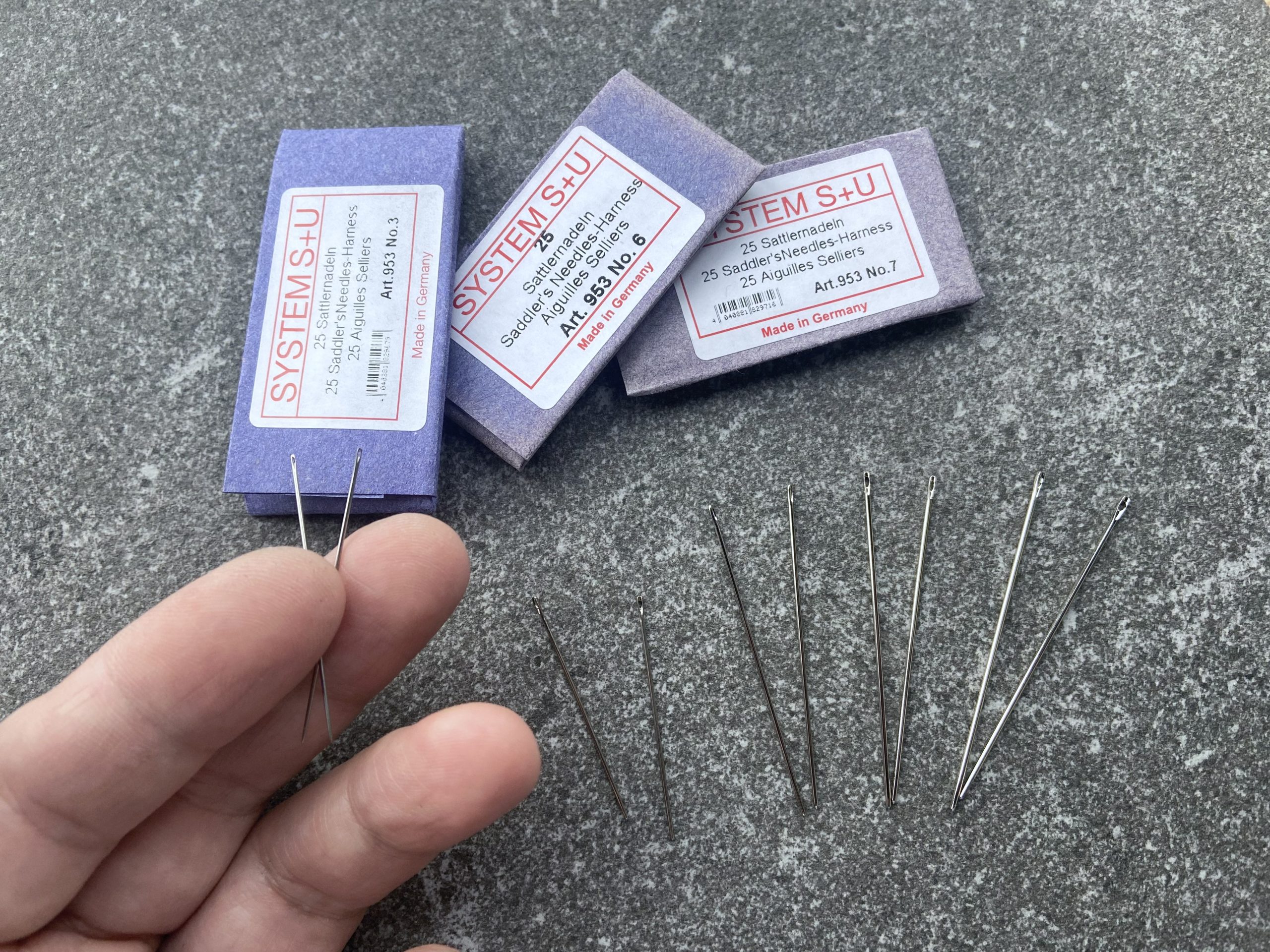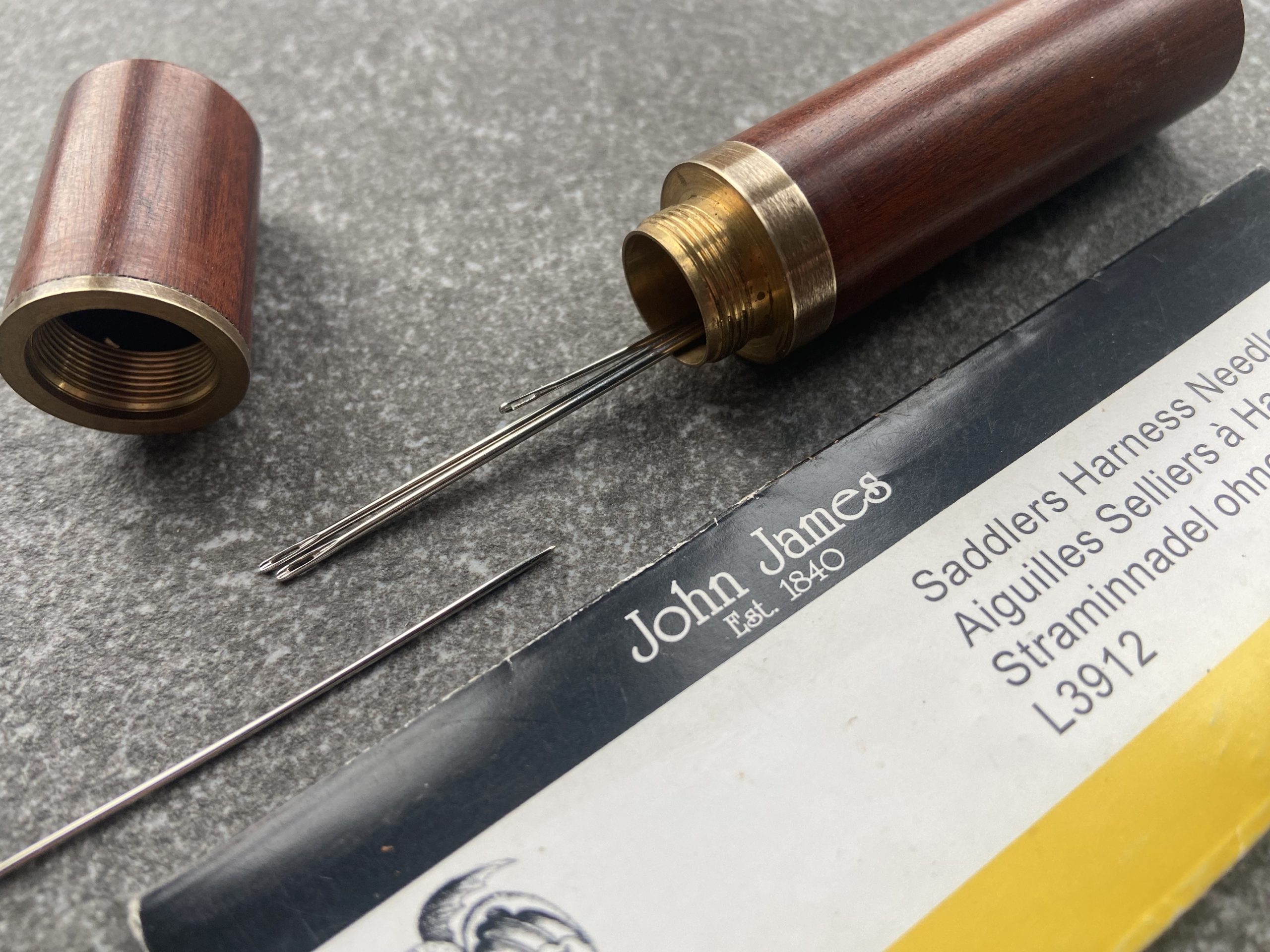Experience with the KOSIM sharpening system: a conversation with leather crafter Victor Kondratenko (V.Kondratenko Studio)
Konstantin (KosiM): Four years ago, Victor came to me with an unusual request: to try the KOSIM sharpening system on his leatherworking tools.м He showed me a set of professional leatherworking tools: knives for cutting and skiving, edge bevelers and awls – tools that look nothing like familiar kitchen or hunting knives. We met at his studio. I brought an Apex-type basic KosiM sharpening system and a set of abrasives: stones made of aluminum oxide 89A (electrocorundum 89A) and silicon carbide (SiC). We turned the camera on and spent several hours selecting a working configuration. Even then it became clear that our standard KosiM sharpening system with adjustable angle and magnets is capable of working in non-standard scenarios as well. All that remained was to choose abrasives with the right grit and bond, and to define the optimal way of fixing and positioning the tool.
Why are we publishing this conversation now?
Firstly, to honestly demonstrate the versatility of the approach: there was no need for any special modifications for Victor. The standard basic sharpening system handled a non-typical task with confidence.
Secondly, to share observations that will be useful for the reader: where the choice of stone really matters, where the method of clamping makes the difference, and where it all comes down to maintaining a stable sharpening angle. And finally, to underline how important it is for us to see how our solutions live in the hands of professionals outside standard use cases.
Let me hand it over to Victor: which tools he uses, and why, in sharpening, functionality matters more to him than a polished appearance.
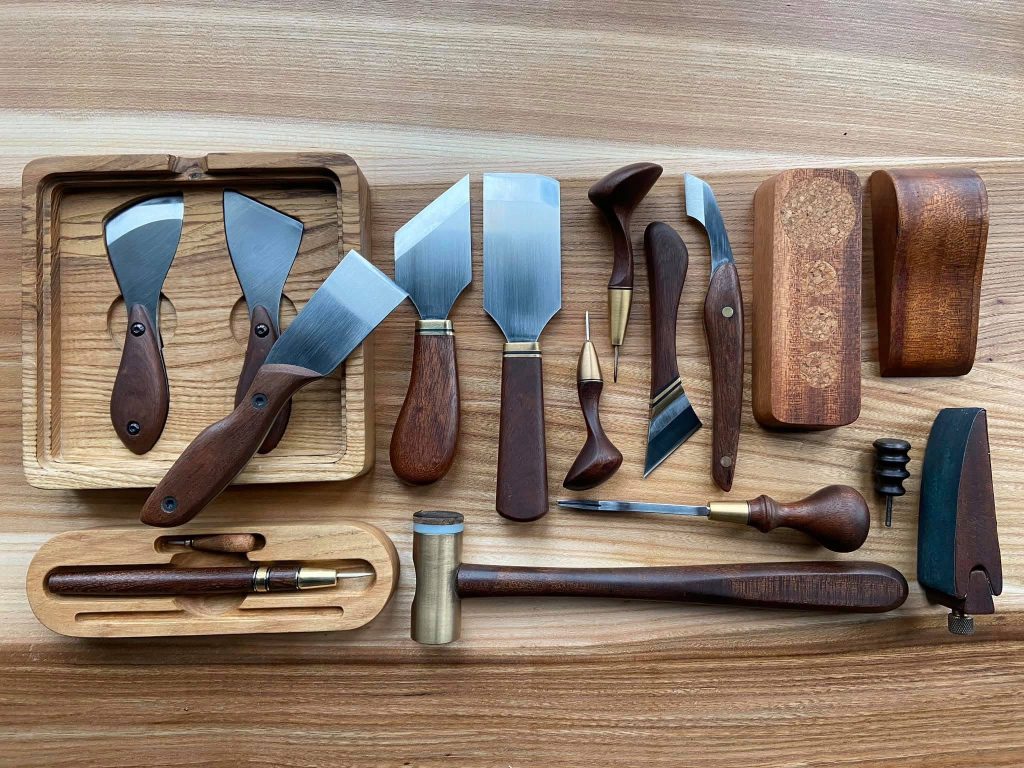
Victor: I remember very well the condition of my knives at that time: the cutting edge needed a full regrind with a changed geometry. At the same time, I already had a wide range of specialized knives: with flat, convex (lenticular) and concave bevels; single- and double-bevel edges; with and without secondary bevels; with working angles starting from 14°. Over time it became obvious: neither steel nor heat treatment can cancel out the physics of wear – the edge gradually dulls and has to be brought back into working condition.
I constantly work with exotic and delicate types of leather, where the price of a mistake is a ruined expensive material, a workpiece (component), or the finished item as a whole. In the making of watch straps with complex shapes and construction, cutting accuracy is as critical as it is for a jeweler or a surgeon. The cut must be precise and clean, dimensions kept within tolerances down to tenths of a millimeter. When splitting and skiving leather with a knife, I often have to thin it down practically “to zero”. That is why sharpness for me is not about aesthetics, but a production necessity.
Sending my knives out to be sharpened turned out to be extremely inconvenient: logistics, time, waiting. And my attempts to sharpen “on the knee”, so to speak, led to distorted angles – it is almost impossible to keep them stable by hand.
At the time I approached Konstantin, I was looking for a practical solution for quick sharpening, touch-ups and fine honing without the risk of ruining the edge geometry. Like many others, I admired the meditative process of sharpening on water stones, but it did not look like a universal solution: too much ritual and too little practical speed, precision and repeatability. I did not need a beautiful ritual, I needed a precise tool that would allow me to set and reliably maintain the angle, give a predictable result and not distract me from the actual work. On top of that, I could not decide on the right set of abrasives.
That is how I eventually came to Konstantin and his KosiM sharpening system. Over the course of several meetings, I essentially rebuilt my understanding of sharpening and ended up with a practical workflow – without any “mirror-polish cult”. Most of the knives in my set are made of D2 steel (60–61 HRC) and, as we established, silicon carbide abrasives work best for them: they perform efficiently on carbon steels and on steels with a hardness starting from about 58 HRC.
We settled on the following FEPA F grit “ladder”:
150 – re-profiling and removing chips;
320 – forming the edge;
600 – refining;
1200 – fine finish.
At first it was not easy to find a correct way to position and fix each knife. The built-in neodymium magnets in the base of the system noticeably simplified working with non-standard shapes.
The real challenge was to dial in the right angles and regrind the entire fleet of knives. During the time I had been sharpening them by hand, I had badly “rolled over” the angles and turned these tools into a textbook example of how things should not be done.
Konstantin (KosiM): Victor, it has already been four years since we first tried the system on your knives. Looking back at this experience, what can you say now? What conclusions – or perhaps practical advice – could you offer to those who are looking for a workable solution for their own tools?
Victor: First, I can confirm that we chose the right type of stones. For my tasks and steels, silicon carbide stones turned out to be ideal. They work excellently with high-alloy and hard steels. Their main advantages are a high metal removal rate and consistent abrasive performance. This made it possible to form the edge effectively even on very dense steels where other abrasives simply “skate” over the surface. In addition, they have a relatively soft bond, which makes the process smooth and controllable: the stone refreshes itself as you work and does not require constant dressing.
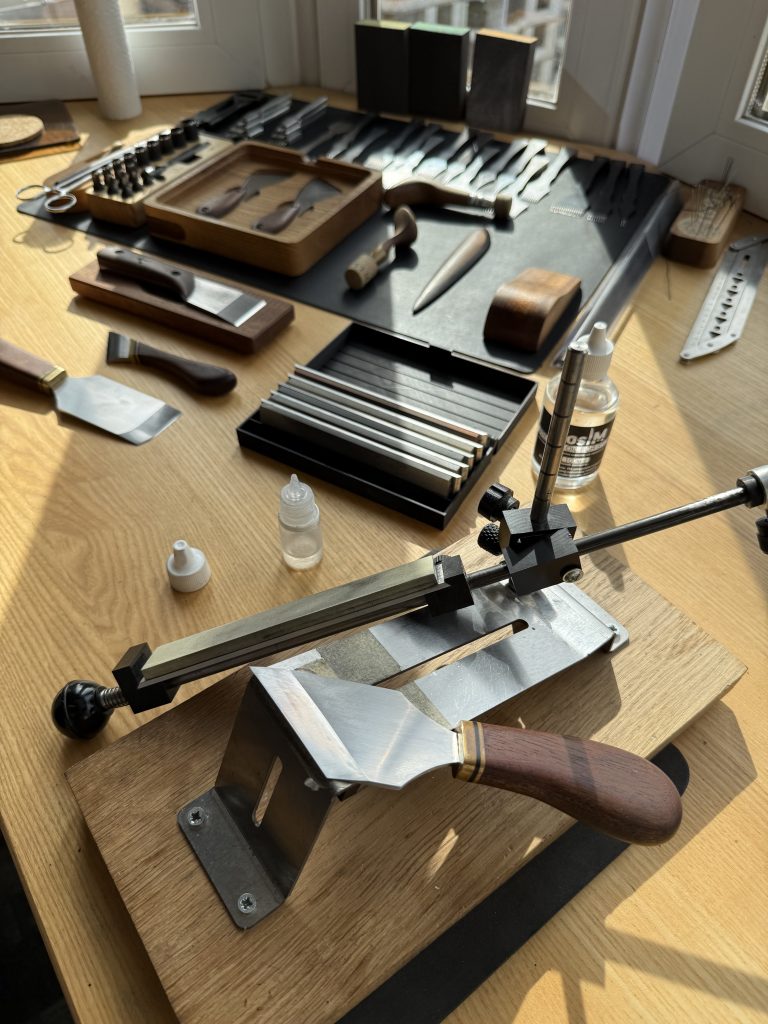
Second, over time I became convinced of how important visual control of sharpening quality is. Even a “perfect” sharpening system does not guarantee the result if you do not inspect the edge with your eyes and, ideally, with optical tools. There are two points you should pay attention to:
The cutting edge. There should be no visible burrs on it – those thin metallic “eyelashes” that sometimes remain after a coarse stone. After the final honing stage, the burr must be completely removed; otherwise the knife will cut “dirty” or not cut at all.
Uniform scratch pattern. Any abrasive leaves microscopic scratches, small grooves. Their uniformity across the entire bevel surface is the best indicator of correct sharpening. If the “pattern” breaks somewhere, or there are untouched areas, it means that either the angle or the pressure were not stable.
Most sharpening systems are designed for knives of classic shape, with conventional geometry and a blade that is easy to clamp across the guide. But the tools I work with are something different, and that is exactly what makes them difficult to sharpen.
Quite recently Konstantin mentioned that he is now working on new add-ons to the basic sharpener that will allow for more flexible clamping of knives with unusual geometry. I believe this is an important step forward, especially for craftsmen who work with non-standard tool shapes.
Konstantin (KosiM): It is exactly for observations like these that we started this interview format in the first place. For us, it is not just an opportunity to talk about sharpening systems (our products), but a way to see the limits of our solutions and understand how those limits can be expanded.
Among our clients there are collectors and owners of antique knives. Many are interested not only in sharpening, but also in modding, storage accessories, sheaths, cases and fitted inserts. It is important for them that all of this looks just as dignified as the knife itself.
And this is where I always think of Victor. In his V.Kondratenko Studio, Victor creates exclusive leather pieces – everything from watch straps to bags – and does it with remarkable attention to detail. Victor focuses on an individual approach and on creating bespoke items from exotic leathers. Each of his commissions is a dialogue with the client, a search for the right combination of materials and forms. I believe this is exactly the point of contact where our clients may overlap.
Victor: For me, it is natural to work at the intersection of craft and art. In my practice there have been knife sheaths with narrative hand carving on leather, as well as cases and boxes with individual fitted inserts for storing and transporting various items, not only knives. Jeweler Sergey Sofronov and I have an ongoing collaboration: for his watch projects I have repeatedly made sets of straps and a storage box with a custom insert. We are now discussing my participation in a composition called “Royal Hunt”. Projects like these always require a detailed discussion of objectives, materials and ergonomics, which is why I work with each commission on an individual basis. Examples of such work are collected on my website in the Bespoke Objects section.
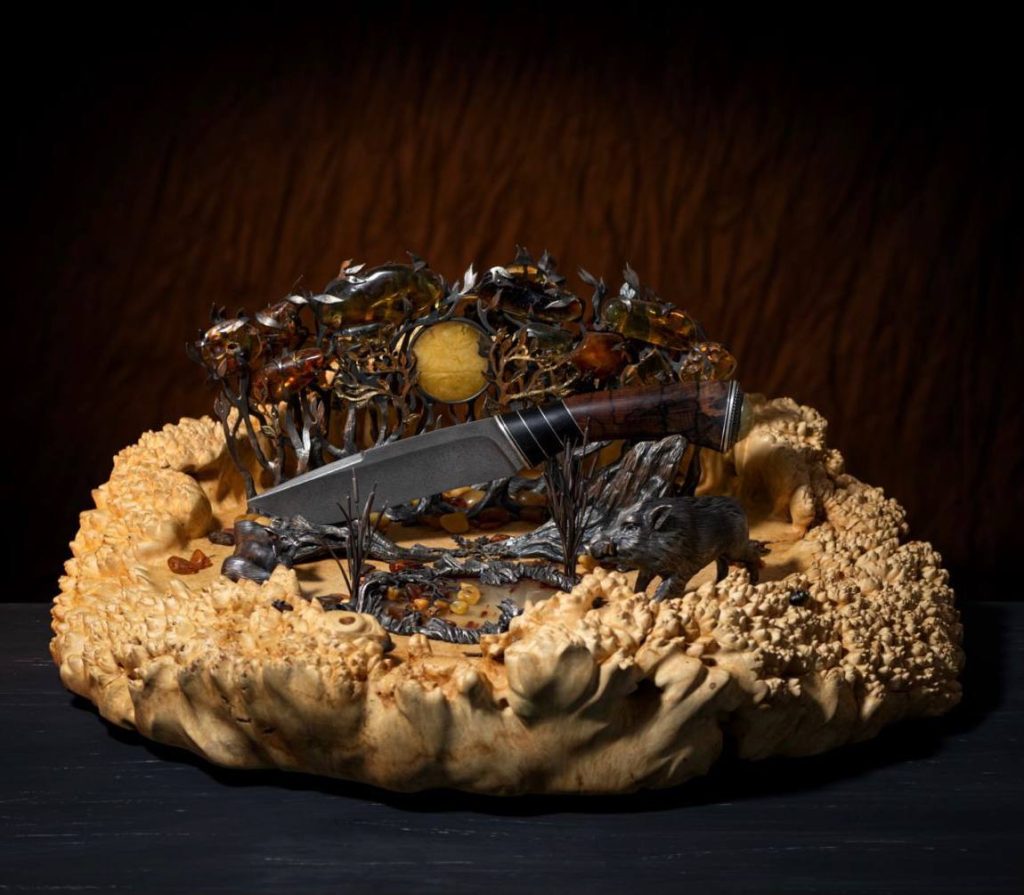
If you have a need and interesting ideas but are not sure how to bring them to life, I am open to dialogue. Feel free to reach out, and we will discuss it. I will help with selecting materials and with implementation.
Konstantin (KosiM): It is exactly such stories that show how the precision of metal meets the plasticity of leather. Our systems help craftsmen maintain a stable angle and achieve repeatable results – and from there, the space for creative interpretation begins. We would like to thank Victor for sharing his experience so openly and for the invitation to take a closer look at the “Royal Hunt” project. I am sure readers will find both practical value and inspiration for their own tasks in this material.
These are not just storage items, but independent art objects in their own right, where every detail is designed for a specific piece. Each such project is always a bespoke commission, built from scratch with the character of the object and its owner in mind. And, perhaps, this is precisely what makes such projects truly alive.
This interview was prepared in collaboration with KOSIM sharpening systems and is also published on the official KosiM website in Eng, Ua and Ru.


